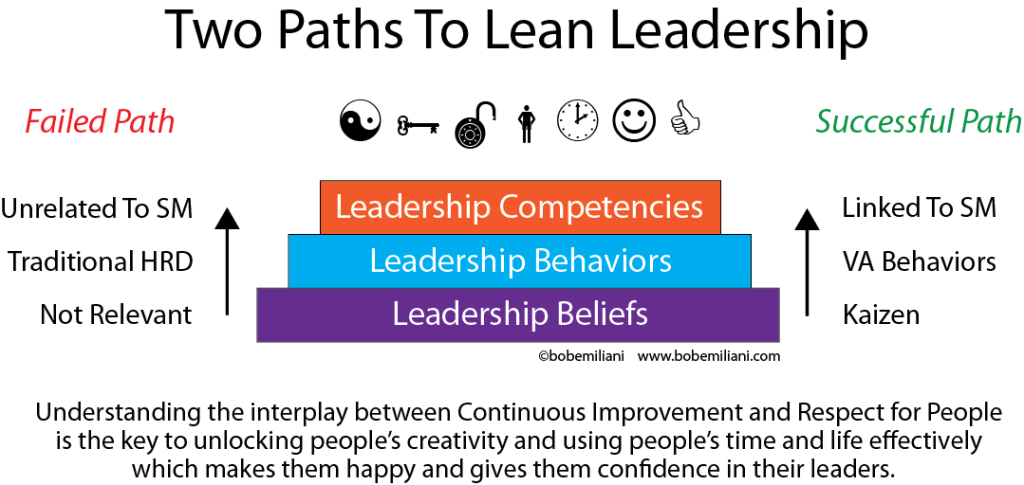There are only two paths to Lean leadership that people can take. One path, based on traditional human resource development models, nearly always results in failure. The second path nearly always results in success, but precious few leaders are willing to take his path. The image below illustrates the two paths:

The failed path (left side of image), based on traditional human resource development (HRD) models, begins with the assumption that the beliefs possessed by all leaders is the same. For example, all leaders believe that the purpose of business is to maximize shareholder value, what gets measured gets managed, employees are to blame for errors, and suppliers are nothing more than entities to bargain with to reduce costs. Clearly, not all leaders share these beliefs.
Next, the traditional human resource development approach tries to get people to change their behaviors. They use various methods for doing this, but best the outcome is usually limited to short-term improvement in a few of one’s worst behaviors. Finally, the leadership competencies associated with the behaviors are not grounded in the scientific method (SM). Cause-and-effect, therefore, is misunderstood or ignored in HRD models.
Therefore, this path, which 98 percent of people take, is highly unlikely to produce capable Lean leaders. But, leaders love it because they are minimally challenged and can easily avoid accountability.
Please think about this: Traditional approaches human resource development are designed to fix problems within the context of wasteful batch-and-queue processing, not flow. If successful, the best it can do is result in a marginally more humane batch-and-queue, blame-oriented environment.
Contrast that to the successful path (right side of image), based on the application of Lean principles and practices to leadership development. This is what I have been working on for twenty years (see Practical Lean Leadership and Speed Leadership). Beliefs among leaders are not assumed to be the same among all leaders. The process by which leaders quickly gain new beliefs about business is kaizen. Aspiring Lean leaders, therefore, must begin by participating in kaizen.
Leaders learn to see the difference between value-added (VA) behaviors and behavioral waste as a result of their experiences with shop floor and office kaizen. Both the behaviors and resultant competencies are tightly linked to the scientific method (e.g. cause-and-effect). This difference between the successful method and failed method is plain.
The successful path requires leaders to accept a big challenge and take responsibility for learning and improvement. They cannot opt out or avoid accountability.
This, in turn, leads to additional insight and learning about how Lean principles and practices apply to leadership processes and what it means to be a capable Lean leader.
